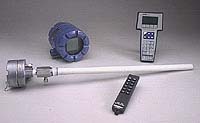
|
In-Situ Oxygen Analyzer - Hi-Temp 2-Wire HART Smart
(550-1600°C) (5081FG)
Traditional in situ oxygen flue gas analyzers
utilize zirconium oxide sensors to measure excess oxygen in process flue
gas. These zirconium oxide sensors use a principle of operation based on
the Nernst equation. This principle requires that the sensor cell be maintained
at a high operating temperature using a heater that is powered via the analyzer's
electronics. Many operators of combustion processes have applications that
involve hazardous gases in the process itself or in the ambient gases in
the area where the analyzer's electronics are installed. These operators
are often concerned that the cell heater can serve as an ignition source
to these hazardous gases inside the process or that the electronics can provide
ignition to hazardous process or ambient gases that may be present. As a
result of these concerns, these users must purchase oxygen analyzers with
costly protection features. In addition, traditional in situ oxygen analyzers
use metallic alloys that are also limited to temperatures in the range of
701°C (1300°F). This process temperature limitation prohibits the
analyzer from being inserted close to the actual combustion process. Many
operators prefer to measure flue gas oxygen close to the furnace or radiant
section for a more representative O2 measurement. Improved analyzer accuracy
can often result in significant fuel savings or improved process throughput.
 Data
Sheet Data
Sheet
|

|
Model 375 HART Field Communicator
A portable intrinsically safe communicator that supports all their fieldbus devices. The result is the universal, user upgradeable, intrinsically safe, rugged and reliable 375 Field Communicator. The 375 Field Communicator is designed to support all HART® and all FOUNDATION™ fieldbus devices from all vendors.
 Data Sheet
Data Sheet |





